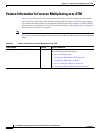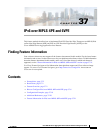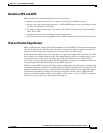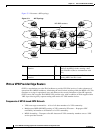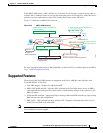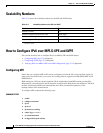
37-3
Cisco ASR 901 Series Aggregation Services Router Software Configuration Guide
OL-23826-09
Chapter 37 IPv6 over MPLS: 6PE and 6VPE
Feature Overview
Benefits of 6PE and 6VPE
6PE and 6VPE offers the following benefits to service providers:
• Minimal operational cost and risk—No impact on existing IPv4 and MPLS services.
• Only provider edge routers require upgrade—A 6PE and 6VPE router can be an existing PE router
or a new one dedicated to IPv6 traffic.
• No impact on IPv6 customer edge (CE) routers—The ISP can connect to any CE router running
Static, IGP or EGP.
• Production services ready—An ISP can delegate IPv6 prefixes.
• IPv6 introduction into an existing MPLS service—6PE and 6VPE routers can be added at any time.
IPv6 on Provider Edge Routers
6PE is a technique that provides global IPv6 reachability over IPv4 MPLS. It allows one shared routing
table for all other devices. 6PE allows IPv6 domains to communicate with one another over the IPv4
without an explicit tunnel setup, requiring only one IPv4 address per IPv6 domain.
While implementing 6PE, the provider edge routers are upgraded to support 6PE, while the rest of the
core network is not touched (IPv6 unaware). This implementation requires no reconfiguration of core
routers because forwarding is based on labels rather than on the IP header itself. This provides a
cost-effective strategy for deploying IPv6.The IPv6 reachability information is exchanged by PE routers
using multiprotocol Border Gateway Protocol (mp-iBGP) extensions.
6PE relies on mp-iBGP extensions in the IPv4 network configuration on the PE router to exchange IPv6
reachability information in addition to an MPLS label for each IPv6 address prefix to be advertised. PE
routers are configured as dual stacks, running both IPv4 and IPv6, and use the IPv4 mapped IPv6 address
for IPv6 prefix reachability exchange. The next hop advertised by the PE router for 6PE and 6VPE
prefixes is still the IPv4 address that is used for IPv4 L3 VPN routes. A value of ::FFFF: is prepended
to the IPv4 next hop, which is an IPv4-mapped IPv6 address.








